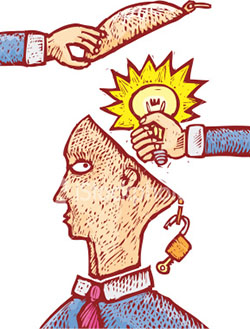
Does intellectual property have the value it once had?
A strong competitive “moat” is one of the features we value in a business. Moats can take many different forms, but one appealing type of moat is that provided by intellectual property, ideally protected by patents.
Companies like Cochlear, Resmed and Codan are good examples of businesses that owe part of their prosperity to technology that provides an edge over competitors. In many cases, this edge has been built and maintained over many years through substantial investments in R&D.
However, as developing nations become increasingly important to the global economy, we have noticed a change in the competitive advantage provided by intellectual property. In particular, we have noticed a trend away from respecting intellectual property rights.
This is a similar phenomenon to the “rip-offs” of luxury brands available in street markets, but instead of copying the design of a handbag or a watch, imitators are copying circuit diagrams, casings and software. In some, but not all cases, the intent is to pass the copy off as the genuine article.
We think this may be a significant challenge for companies that rely on IP, particularly given that the enforcement of rights in developing countries often relies on the willingness of the authorities in those countries to take action. Consider for example the situation in India, where the manufacture of generic copies of patented drugs is officially sanctioned by the courts, as this provides the best outcome for Indian manufacturers and their customers. In many cases, respecting IP rights may simply be viewed as unaffordable.
It is hard to tell how significant this issue will become over time, but for technology companies seeking to expand sales of high-margin products into the growing affluence of developing markets, it is one extra challenge that needs to be navigated. It’s likely that the best companies and managers will evolve to meet it.
Greg McLennan
:
Well, some products are easier to copy than others and I suspect something like Cochlear’s implants might be harder to mimic successfully, particularly where surgeons are involved and have an interest in maintaining their own reputatons. Would they want to risk implanting dodgy doohickeys and destroy their own reputations with a higher failure rate?
Speaking of Cochlear, the share price went under $61 today. The phrase about a wonderful company at a fair price being better than a fair company at a wonderful price is starting to come to mind.
Robert Summers
:
Some clarification on the pharmaceutical situation in India. It is not that IP rights are not respected in India, just that their patent laws were only introduced for pharmaceuticals in 2005. Furthermore, there is embedded a significant section 3(d), that new formulations of old drugs must demonstrate enhanced efficacy. This is, as the previous two comments indicate, an apt response to prevent evergreening. Note that price is not a sufficient enough reason to reject a drug application.
Those two issues together are what have contributed to the recent furor surrounding Novartis’ unsuccessful Glivec case. For further discussion I recommend this recent article: http://www.sciencemag.org/content/337/6093/414.full (note that there is a process in the US whereby secondary patents are challenged too).
More broadly, there is a difficult problem here. Technologies (read IP) arise through company ingenuity and putting shareholder funds at risk. Companies (and shareholders) therefore should rightly expect a return for that risk. The question then might be who pays for that return?
I think the solutions will have to come as a compromise (at least in the example of pharmaceuticals) – if companies intend to expand into developing markets, they may have to accept lower margins. Developed markets might end up paying the bulk of the ‘return on risk’, and emerging markets may not be the golden calf that managers of mature companies have long preached of.
Kshitij Gupta
:
The comment by Dean Magee is correct. To simply paint a 15 year old Rolls Royce and try to sell it for the price of new is fraud, isn’t it? The Indian judiciary is not some Mickey Mouse courts of New York where not a single banker went punished, on the contrary M.F. Global Customers to get their own money back, at a discount no less, must agree to let Corzine off the hook and J.P. Morgan and this is approved by a Federal Judge who is supposed to be impartial.
Your observations are totally incorrect.
It is the customers and competitors who were being defrauded. The courts realized it. India does protect patents. EU does not have the guts to challenge Indian patent laws in WTO. Any guesses why? Because they know they will loose. Indian judiciary is highly reliable, maybe a lot more than Australian judiciary who did little for the plight for Aborigines.
Dean Magee
:
Are the decisions by the Indian courts really made to benefit locals at the expense of foreign drug companies?
Or have they been made to prevent drug companies extending their patents after superficial modifications to their medication?